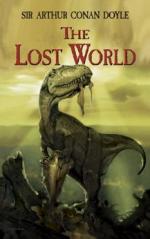“But,” I cried, “surely the whole experience of the human race is not to be set aside on account of a single sketch”—I had turned over the leaves and ascertained that there was nothing more in the book—“a single sketch by a wandering American artist who may have done it under hashish, or in the delirium of fever, or simply in order to gratify a freakish imagination. You can’t, as a man of science, defend such a position as that.”
For answer the Professor took a book down from a shelf.
“This is an excellent monograph by my gifted friend, Ray Lankester!” said he. “There is an illustration here which would interest you. Ah, yes, here it is! The inscription beneath it runs: `Probable appearance in life of the Jurassic Dinosaur Stegosaurus. The hind leg alone is twice as tall as a full-grown man.’ Well, what do you make of that?”
He handed me the open book. I started as I looked at the picture. In this reconstructed animal of a dead world there was certainly a very great resemblance to the sketch of the unknown artist.
“That is certainly remarkable,” said I.
“But you won’t admit that it is final?”
“Surely it might be a coincidence, or this American may have seen a picture of the kind and carried it in his memory. It would be likely to recur to a man in a delirium.”
“Very good,” said the Professor, indulgently; “we leave it at that. I will now ask you to look at this bone.” He handed over the one which he had already described as part of the dead man’s possessions. It was about six inches long, and thicker than my thumb, with some indications of dried cartilage at one end of it.
“To what known creature does that bone belong?” asked the Professor.
I examined it with care and tried to recall some half-forgotten knowledge.
“It might be a very thick human collar-bone,” I said.
My companion waved his hand in contemptuous deprecation.
“The human collar-bone is curved. This is straight. There is a groove upon its surface showing that a great tendon played across it, which could not be the case with a clavicle.”
“Then I must confess that I don’t know what it is.”
“You need not be ashamed to expose your ignorance, for I don’t suppose the whole South Kensington staff could give a name to it.” He took a little bone the size of a bean out of a pill-box. “So far as I am a judge this human bone is the analogue of the one which you hold in your hand. That will give you some idea of the size of the creature. You will observe from the cartilage that this is no fossil specimen, but recent. What do you say to that?”
“Surely in an elephant——”
He winced as if in pain.
“Don’t! Don’t talk of elephants in South America. Even in these days of Board schools——”
“Well,” I interrupted, “any large South American animal—a tapir, for example.”




